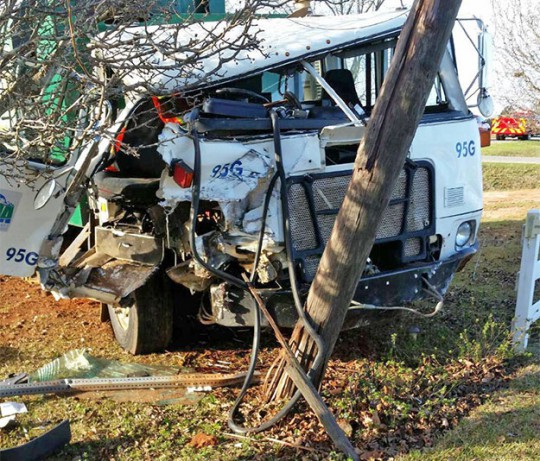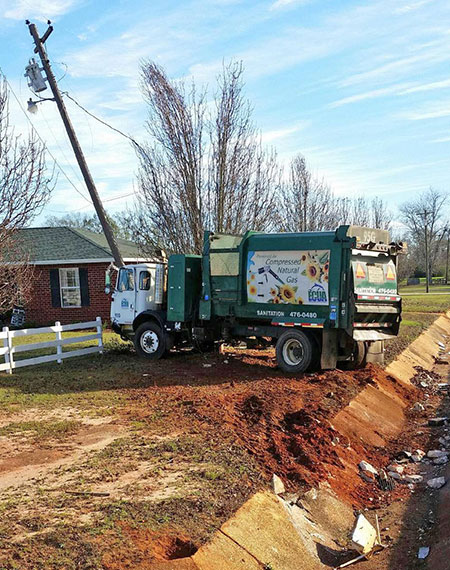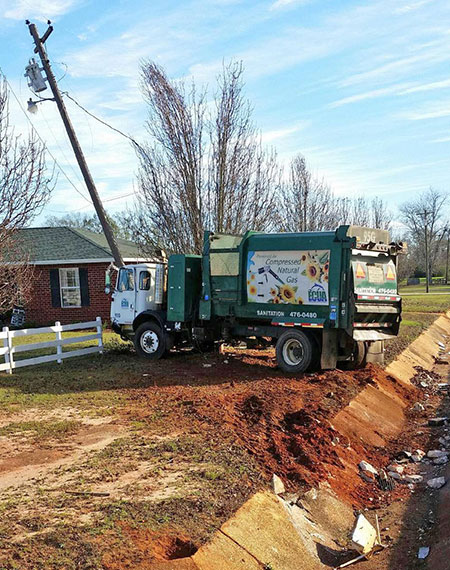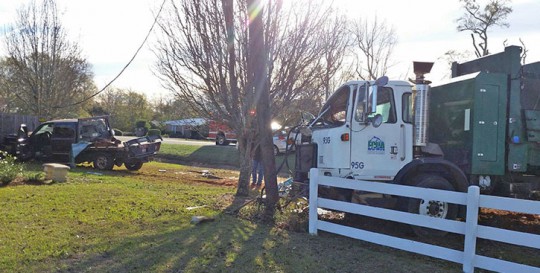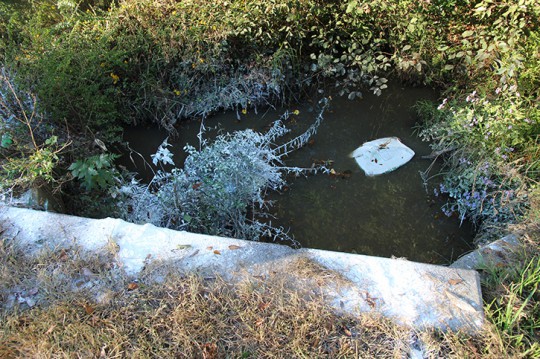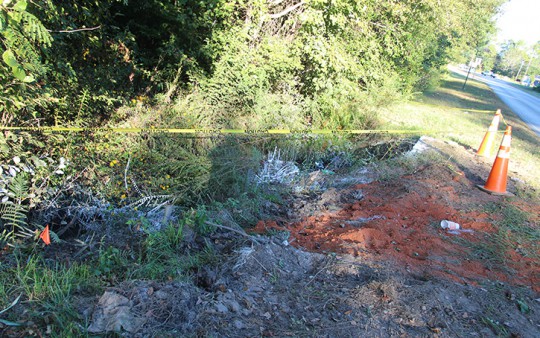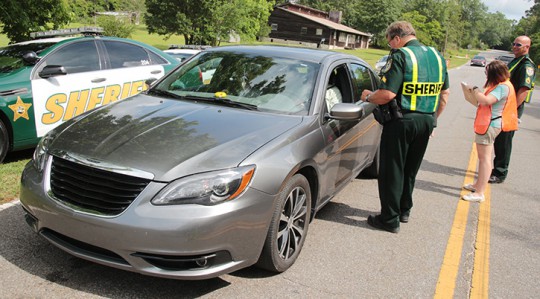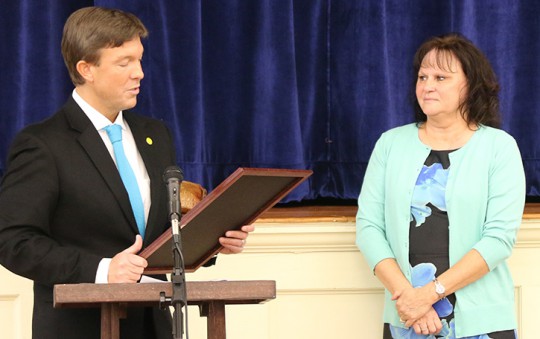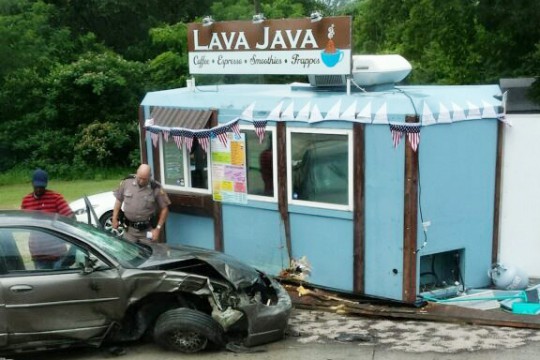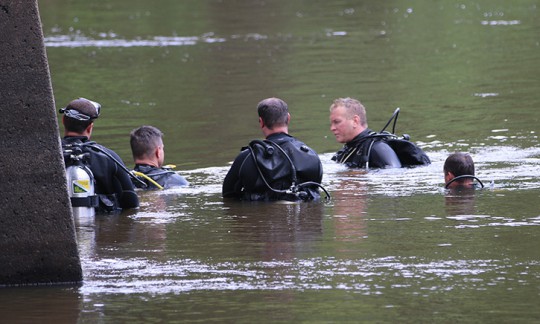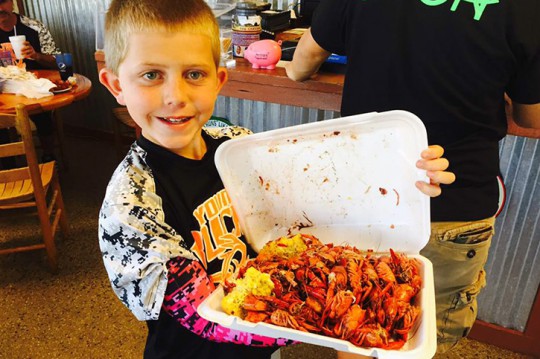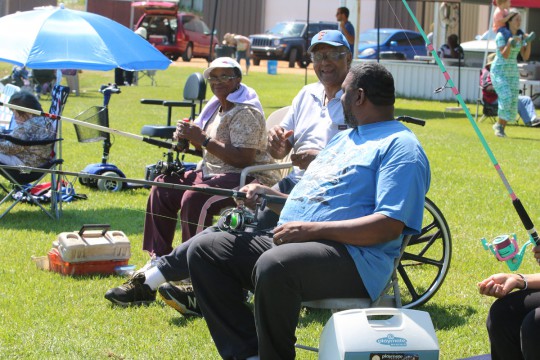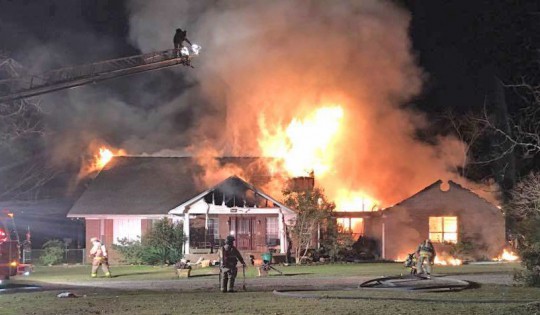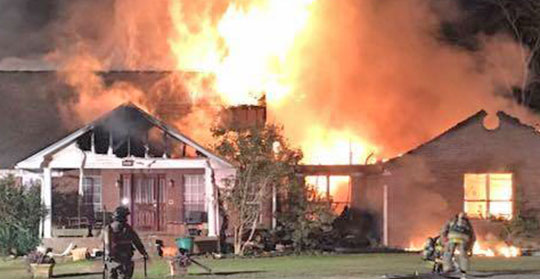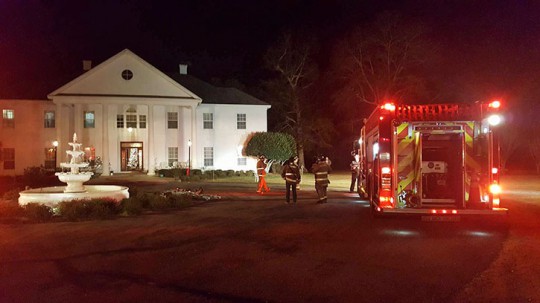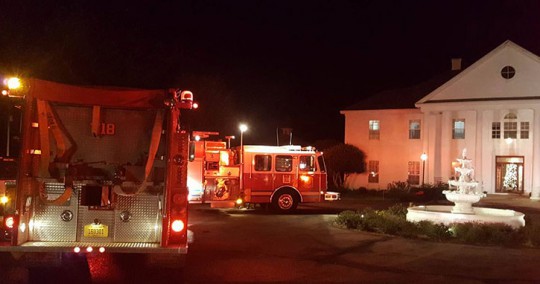Another House Fire: 12th Red Bulb Placed On Fire Safety Wreath
December 31, 2016
A fire in the 1000 block of South Fairfield Drive Friday marked the 12 the red bulb to the place on the “Keep the Wreath Green” fire safety wreath.
 Escambia County Emergency Communications received multiple calls reporting a structure fire Friday, December 30 at 10:45 a.m. Crews arrived on scene to find a working fire in a single-wide mobile home, with fire visible from a bedroom window.
Escambia County Emergency Communications received multiple calls reporting a structure fire Friday, December 30 at 10:45 a.m. Crews arrived on scene to find a working fire in a single-wide mobile home, with fire visible from a bedroom window.
The fire was called under control at 10:57 a.m. No one was injured in the fire, but the home was a total loss displacing the residents.
The American Red Cross is assisting one adult and two children and the Florida State Fire Marshal is investigating the cause of the fire. The following Escambia Fire Rescue Stations responded: Warrington, Myrtle Grove, Pleasant Grove and Osceola. The NAS Pensacola Fire Department also assisted.
The 10th and 11th red bulbs were following fires in the Cantonment area. Click here and click here for more information and photos.
The “Keep the Wreath Green” fire safety campaign is a collaborative initiative with the city of Pensacola to promote fire safety during the month of December. During the month-long campaign, five-foot wreaths are on display at 18 county fire stations and five city fire stations, with wreaths also placed outside Escambia County’s Ernie Lee Magaha Government Building downtown, the Escambia County Public Safety Building, Pensacola City Hall and Cordova Mall near the food court entrance. Each time firefighters respond to a residential fire with damage, a green light bulb will be replaced with a red one to remind citizens of the dangers posed by fires in residential home.
ECUA Truck Crash Causes Power Outage
December 31, 2016
An Emerald Coast Utilities Authority truck was involved in an accident Friday morning near Jay that left numerous Escambia River Electric Cooperative customers without power.
Further details on the crash at Harvest Road and North Simmons Road, including information on any injuries, have not been released by the Florida Highway Patrol.
Photos courtesy Jay VFD for NorthEscambia.com, click to enlarge.
Judge Tosses Pollution Notification Rule
December 31, 2016
In a victory for business groups, an administrative law judge Friday ruled that the Florida Department of Environmental Protection overstepped its authority in proposing new requirements for notifying the public when pollution occurs.
The department proposed the notification requirements after high-profile pollution incidents involving a sinkhole at a phosphate plant in Polk County and sewage discharges into Tampa Bay.
But Associated Industries of Florida, the Florida Farm Bureau Federation, the Florida Retail Federation, the Florida Trucking Association and the National Federation of Independent Business challenged the proposed rule in the state Division of Administrative Hearings.
Judge Bram D.E. Canter issued a 21-page order Friday siding with the business groups’ arguments that the department does not have authority under state law to impose the notification requirements on people or businesses responsible for pollution releases. In part, the arguments dealt with proposed requirements for notifying the public through the news media when pollution occurs.
Canter wrote that state law only requires that the Department of Environmental Protection be notified about incidents such as spills or contamination.
“There is no statute that specifically authorizes DEP to adopt a rule which requires persons to notify entities other than DEP when there is a release of a contaminant,” Canter wrote.
The proposed rule came after incidents that included a sinkhole opening at a Mosaic fertilizer plan in Polk County and sending contaminated water into the Floridan Aquifer. Also, it followed St. Petersburg spilling large amounts of sewage into Tampa Bay after Hurricane Hermine.
The proposal called for such pollution incidents to be reported to the Department of Environmental Protection, the news media and local governments within 24 hours. Also, the proposed rule included reporting requirements such as notifying adjacent property owners when pollution travels off-site.
In a document filed Dec. 14, attorneys for the business groups argued that the department’s “haste to respond to the Mosaic sinkhole incident and the St. Petersburg release led to this broad rule and led FDEP to disregard their lack of statutory authority.”
“Under its (the proposal’s) terms, for example, truckers with a fuel spill over 25 gallons can be required to contact the media and local government about the spill,” the document said. “Small businesses, such as dry cleaners and gas stations, that use solvents and petroleum can likewise be swept up within the rule for small releases that pose no realistic danger to human health, whether or not it was prompted by events beyond their control. Under this broad variety of circumstances and businesses, all the entities covered by this rule will be required to contact local media, who have no training and little experience in assessing environmental releases, and who may cause an overreaction, unnecessary panic, and damage a (business’) reputation.”
But department attorneys, in a document filed the same day, contended the agency had the legal authority to require the stepped-up notification.
“The department reasonably interpreted the statute by defining a set of circumstances that presented a threat to human health, and by placing special emphasis on that set of circumstances,” the department attorneys wrote.
While Canter sided with the business groups, the issue of public notification of pollution incidents could re-emerge during the 2017 legislative session, which starts in March. Sen. Bill Galvano, R-Bradenton, and Rep. Kathleen Peters, R-Treasure Island, indicated in September that they would propose legislation to address the issue.
McKinley Lewis, a spokesman for Gov. Rick Scott, said in an emailed statement late Friday afternoon that the Scott administration remains committed to increased public notification.
“Protecting Florida’s pristine environment is DEP’s top priority and they will continue the public pollution notification process to ensure all Floridians and visitors are notified of pollution incidents,” Lewis said. “Governor Scott has been clear that the current law is outdated and needs to be changed. That is why earlier this year he directed DEP to implement an emergency rule and announced that he will fight for legislation that ensures Florida families and visitors are notified within 24-hours of a pollution incident. We will review the judge’s order to determine next steps.”
by Jim Saunders, The News Service of Florida
Pictured: The Town of Century had 500 gallon sewage spill into this ditch near the Century Woods Apartment on West highway 4 on October 20. NorthEscambia.com photos, click to enlarge.
Florida 2016 Roundup: Kind Of Weird News, Huh?
December 31, 2016
In 2016, Donald Trump was elected to the White House. The Cubs won the World Series. And Bob Dylan was awarded the Nobel Prize in Literature.
In other words, it was the kind of year that seemed designed to make Florida news look normal.
But even if the relative weirdness of developments in the Sunshine State was down a notch, Florida residents still had plenty to keep them occupied, amused or in some cases terrified.
 Two favorite sons who had been among the frontrunners for the presidency failed to get much traction — and one of them, U.S. Sen. Marco Rubio, reneged on a pledge not to run for a second term. The state’s death penalty sentencing structure was overturned, “fixed” and then overturned again. Two years after rejecting full-strength medical marijuana at the polls, Florida voters decided without much fanfare that pharmaceutical ganja might not be that bad.
Two favorite sons who had been among the frontrunners for the presidency failed to get much traction — and one of them, U.S. Sen. Marco Rubio, reneged on a pledge not to run for a second term. The state’s death penalty sentencing structure was overturned, “fixed” and then overturned again. Two years after rejecting full-strength medical marijuana at the polls, Florida voters decided without much fanfare that pharmaceutical ganja might not be that bad.
There was also tragedy. The state was hammered by two hurricanes, faced an outbreak of the previously unfamiliar Zika virus and endured the worst mass shooting in American history. For many Floridians, 2016 probably couldn’t end soon enough.
Perhaps 2017 will allow Florida to reclaim its undisputed mantle as the weirdest state in the nation — but for the amusing mixture of fast food and strange crimes and not for the darker reasons that sometimes played out in 2016.
FLORIDA, FLORIDA, FLORIDA (I)
With apologies to Benjamin Franklin, there are a few certainties of life in Florida: summer heat, low attendance at Miami sporting events and a deluge of visits from presidential candidates every four years. The last of those put the state in the spotlight during one of the weirdest presidential campaigns in recorded American history — no hyperbole.
After amassing a nine-digit money hoard before the Republican presidential primary even began in earnest, former Florida Gov. Jeb Bush started the campaign as the undisputed favorite. But he was already limping by the time 2016 began, with News Hurricane Donald coming ashore and rivals like Rubio trying to eat away at Bush’s establishment base.
One of the clearest signs that Bush and Rubio were both failing to gain serious momentum was that political figures inside their home state were hedging bets, or even leaning a bit toward Trump. Gov. Rick Scott did not make a formal endorsement ahead of the state’s March 15 primary, but he had basically already signaled his choice, penning a USA Today opinion piece headlined, “Donald Trump has America’s pulse.”
The multi-multi-millionaire governor credited the billionaire real-estate developer as someone “who speaks and tweets his mind freely.” Scott said Trump’s standing in the polls was more about Trump’s ability to capture “the frustration of many Americans after seven years of President Obama’s very intentional government takeover of the American economy.”
Whatever it was, it worked. Bush was out by late February, after a string of embarrassing results ended with a fourth-place showing in South Carolina. Rubio hung on until Florida, eventually getting into an insult war with Trump that included suggestions about the size of the businessman’s manhood. But then Trump had almost grown inevitable, even before Attorney General Pam Bondi endorsed the bombastic billionaire on primary eve. Trump crushed Rubio by nearly 20 percentage points.
With Florida voters having made their decision, Scott then lined up behind Trump. And to borrow one of Trump’s famous phrases, he kept winning and winning and winning, ending up as the Republican nominee.
Florida was soon back to center stage. Former Secretary of State Hillary Clinton, the Democratic nominee, emphasized the importance of Florida by visiting the state to give what amounted to a rebuttal of the Republican National Convention before heading to her party’s gathering the following week.
“I know there’s a lot of angst. I understand all that. And I respect those who have legitimate concerns and questions. But I’ve never known America to quit on ourselves. I’ve never known us to give up on the face of tough challenges … to retreat in the kind of isolation that was being advertised at their convention,” she said. “That is not who we are. Those are not the values that made us a great country.”
Trump also made frequent trips to Florida, including an October stop in Panama City Beach, where he suggested that the Army Corps of Engineers could prevent droughts by not releasing water from Lake Okeechobee, and blamed a global elite for the problems facing the nation.
“This election will determine whether we remain a free country in the truest sense of the word or we become a corrupt banana republic controlled by large donors and foreign governments,” Trump told the crowd. “The election of Hillary Clinton would lead to the destruction of our country.”
Democrats banked on the state’s increasing diversity to win Florida and its 29 electoral votes. Republicans counted on a surge of working-class white voters. By the end of election night, it was clear which plan had worked: Trump carried the state en route to winning the White House.
FLORIDA, FLORIDA, FLORIDA (II)
If there was a level of government in Florida that was reshaped most by the 2016 elections, it was the state’s congressional delegation. Between redistricting, retirements and even an indictment, there will be plenty of new faces in Florida’s contingent of U.S. House members when they formally take office in January.
Some of the faces will even be moving around. Republican Congressman Dan Webster moved to run for an open seat stretching from Lake County to the Gulf Coast after his Orlando-area district was redrawn as part of a legal battle over gerrymandering. What was left of Webster’s district was almost unwinnable for a Republican candidate.
Either because of redistricting or other reasons, many members just left. Republican Congressmen Curt Clawson, Ander Crenshaw, Jeff Miller and Rich Nugent all stepped aside. (And would have been joined by GOP Reps. Ron DeSantis and David Jolly but for a change of heart by Rubio on his U.S. Senate seat.) Democratic Congresswoman Gwen Graham bowed out of a redrawn and strongly Republican seat, while Democratic Congressmen Alan Grayson and Patrick Murphy battled for the party’s Senate nomination.
Others fought. Democratic Congresswoman Corrine Brown, gearing up to seek a 13th term, filed a federal lawsuit alleging that the state’s new congressional districts violated the Voting Rights Act by illegally weakening the ability of African-American voters to elect candidates of their choice. Brown’s district was reoriented from a north-south district that ran from Jacksonville to Orlando to an east-west configuration that runs from Jacksonville to Gadsden County and included a good part of Tallahassee.
But federal judges rejected her lawsuit in April.
Things got worse for Brown in July, when she was indicted on charges that she and a top aide used a sham education charity to pay for personal expenses and luxurious events. Brown pleaded not guilty, but the allegations clearly took a toll on her Democratic primary race against former state Sen. Al Lawson and LaShonda “LJ” Holloway. Still, Brown remained her pugnacious self.
“Are you a pedophile? No,” she said to a reporter who asked a question about the indictment — her way of demonstrating that everyone is innocent until proven guilty.
Brown lost her bid for re-election to Lawson. Meanwhile, U.S. Rep. Debbie Wasserman Schultz, a Democrat who resigned from her post as chairwoman of the Democratic National Committee amid controversy this summer, fought off a primary challenge from Nova Southeastern University law professor Tim Canova.
Two more incumbents went down in November: Jolly lost to former Gov. Charlie Crist, a onetime Republican running as a Democrat, while Republican Congressman John Mica was ousted by political novice Stephanie Murphy.
One person who surprisingly didn’t leave office: Rubio, who had initially vowed that he wouldn’t run for re-election to the Senate. But after his presidential bid fizzled and with a virtual parade of Republican leaders begging him to reconsider, Rubio re-entered the Senate race and handily beat Murphy, his Democratic opponent.
“I am glad that I’m an American in the 21st Century,” he said following his victory. “America is going to be OK. We will turn this country around. I have faith. I know God is not done with America yet.”
TINKERING WITH THE MACHINERY
Lawmakers were happily going through the motions of the first day of the 2016 legislative session when the U.S. Supreme Court threw a monkey wrench in the proceedings, striking down Florida’s death-penalty sentencing system as unconstitutional.
In its 8-1 opinion, the Supreme Court ruled that Florida’s unique law giving judges the ultimate power to decide whether to impose the death penalty amounted to a violation of the Sixth Amendment right to trial by jury.
The immediate result was confusion. Once lawmakers began grappling with the issue, though, the House and the Senate split on how far-ranging the reforms to the death penalty should go. Senators pushed for requiring unanimous jury recommendations before death sentences could be imposed. The House proposed increasing the jury threshold for imposing capital punishment from a simple majority to a 9-3 vote.
“The Senate feels that if we go to 9-3 that we’ll be back in a few years, going through this again,” said then-Senate Criminal Justice Chairman Greg Evers, R-Baker.
Lawmakers ultimately compromised on a 10-2 margin for jury recommendations on death sentences. And it didn’t even take a few years. The Florida Supreme Court struck down the new law in October, saying unanimity was needed in death sentences.
“Simply put, Florida’s extreme outlier status in not requiring unanimity in the jury’s final recommendation renders the current imposition of the death penalty in Florida cruel and unusual under the Eighth Amendment of the United States Constitution,” Justice Barbara Pariente wrote in a concurring opinion to the court’s decision.
Then, in December, the court ruled that inmates sent to Death Row after a 2002 U.S. Supreme Court decision should be able to seek new sentencing proceedings. The ruling is expected to pave the way for about 55 percent of the state’s 386 Death Row inmates to seek new sentencing proceedings — though it didn’t help inmates sentenced before the 2002 decision.
Meanwhile, there was a chance that the Florida court’s ideological balance might change, ever so slightly. Justice James E.C. Perry will leave the court at the end of the year due to mandatory retirement. Scott chose C. Alan Lawson, chief judge of the Daytona Beach-based 5th District Court of Appeal, to replace Perry.
Lawson is expected to be more conservative than Perry.
“The Supreme Court, and the courts, do determine whether a law is constitutional or not,” Lawson said. “From the very beginning, that right of the branch also came with a promise that it would be exercised with judicial restraint.”
FLORIDA BUGS OUT
It might sound like a flavorful dish from a Mediterranean country, but Floridians found out this year that Zika is actually a serious virus.
At first, state officials tried to calm the situation by pointing out that many of the cases of the mosquito-borne virus stemmed from people traveling to countries where Zika was active. But then, evidence emerged that local mosquitoes were also carrying the disease in some areas, and suddenly the cases seemed to be coming like a drumbeat. Two new local cases on Aug. 15. Twelve travel-related cases the next day. Three local cases the day after that. And so on.
Scott began criticizing President Barack Obama and the Republican-controlled Congress for failing to come to an agreement on funding to combat the disease. He traveled to Washington to personally lobby for the funding. The governor also tried to tamp down fears about the virus, noting that local transmission was only happening in relatively small areas of Miami-Dade County.
“We have a safe state, and we’re going to keep it that way,” Scott said in August.
Finally, in September — seven months after Scott had first sounded the alarm — Congress passed a Zika bill. By December, Scott was able to announce that the last remaining area in Miami-Dade where Zika was being transmitted by mosquitoes had been cleared. But with warm weather and the accompanying bugs bound to return, there were questions about how long the reprieve would last.
TERRORISM STRIKES FLORIDA
A more sudden and brutal tragedy came in June, when shots rang out early one morning at the Pulse gay nightclub in downtown Orlando. By the time it was over, St. Lucie County resident Omar Mateen, 29, had killed 49 people before being shot dead by police.
Despite their varying views on gun control and LGBT rights, leaders from across the political spectrum condemned the violence and mourned the victims.
“We know that there’s hate in the world,” Rubio said. “We know that some of it is inspired by warped ideology. … I hope they see today they won’t terrorize America. They won’t terrorize Floridians. We stand with all Americans … irrespective of their sexual orientation.”
But divisions didn’t take long to emerge, particularly on the issue of gun control. Democrats tried to pressure Republicans to call a special session to deal with firearms legislation. GOP leaders responded by painting the requests as crass politics.
Republicans also stirred the pot. Barely a week after the massacre, Evers — who was running for Congress — drew criticism for plans to give away a semiautomatic rifle similar to the one used in the Pulse attack.
“With terrorism incidents on the rise, both at home and abroad, protecting our constitutional rights has never been more important,” Evers said in a prepared statement.
LGBT activists, in particular, were outraged.
“I think it is tasteless, disrespectful, disgusting, political pandering at its worst,” said Stratton Pollitzer, deputy director of Equality Florida, an LGBT advocacy group. “The idea that he wants to put the same style assault rifle that was just used for mass murder into the hands of a random stranger is grotesque.”
As they had before on gun-related issues, Democrats used a provision of the state Constitution to force a poll of legislators on whether to hold a special session. As such drives had before, this one failed.
HELLO HURRICANES
Not long before the Pulse shootings, a far different kind of tragedy was on the minds of people gathered in Orlando, as the Governor’s Hurricane Conference drew warnings about complacency and “hurricane amnesia.”
If there was any forgetfulness, or a complete lack of memories in the case of new residents, it was wiped out in 2016, when Florida was lashed by not one but two of the tropical storm systems.
Hurricane Hermine crashed into the state’s Gulf Coast in September, making landfall near St. Marks as a Category 1 hurricane. The storm knocked out power to hundreds of thousands of residents. The pace of restoring that power caused clashes between Scott and Tallahassee Mayor Andrew Gillum, seen as a rising star in the Democratic Party.
Hurricane Matthew was a worse storm, but Florida avoided a direct hit. That didn’t keep the hurricane from doing damage as it barreled up the East Coast. The storm plunged more than 1 million homes and businesses into the dark. Still, Scott said Florida was “blessed.”
“If it had a direct impact hit, it would have been a lot worse for our families,” he said.
In all, damages from the storms reached almost $1.6 billion by December. Those numbers didn’t include agricultural losses and some damages that local governments are handling without state assistance.
QUOTES OF THE YEAR:
“Sometimes I go to happy hour and I have one drink. Sometimes I end up closing the bar and wind up at the Waffle House at 3 a.m.”— Orlando lawyer John Morgan, in May, saying he had “no clue” how much he would spend to support the medical marijuana initiative on this year’s ballot.
“We probably should just schedule the same conversation about every seven days, it appears.”—state Chief Financial Officer Jeff Atwater, in August, asked to respond to the latest comments from GOP presidential nominee Donald Trump that caused widespread outrage.
“I don’t mean this literally, but he’s going to blow the place up. And I mean that in a good way.”—Former lawmaker Mike Fasano, Pasco County tax collector, in November, on incoming House Speaker Richard Corcoran, R-Land O’ Lakes.
“Politically, the challenge in this really kind of crude environment is to go beyond being against what’s not working and being for things that will work, that will lift people up. And I tried that and totally failed, miserably. I mean, like, belly flop — bam.”—Former Florida Gov. Jeb Bush, in December, on his presidential bid.
“Lastly, I appreciate Pitbull and his devotion to our great state.”—Gov. Rick Scott, in a letter detailing proposed reforms to Visit Florida, prompted in part by outrage over a contract the Miami rapper got to promote tourism in Florida.
by Brandon Larrabee, The News Service of Florida
2016 In Photos: May
December 31, 2016
Today, we continue our look back at the year 2016 in photos with a look at May.
The Northview Chiefs defeated the Jay Royals in spring football action.
Work was completed on the replacement of a 75-year old Highway 97 bridge over Little Pine Barren Creek in Walnut Hill.
The Escambia County Sheriff’s Office held a Clean Sweep operation Thursday in the Cottage Hill area.
Clara Gulsby retired after 26 years with the Escambia County Tax Collector’s Office.
The Tate High School Class of 2016 graduated at the Pensacola Bay Center. Valedictorian was Angel Chu.
The Northview High School Class of 2016 graduated in May. Valedictorian was Bethany Reynolds.
The Camp Fire USA Century Youth Learning Center held a graduation program.
A popular Cantonment drive thru coffee shop was temporarily closed after being struck by a vehicle during a traffic accident.
A local couple with cerebral palsy married in an emotional ceremony in Century.
Bratt Elementary School “Book-aneers” had a chance to visit the “Treasure Library” Friday — a year end treat for students with most “AR” — advanced reader — points.
Reimagine Century breathed new life info Century, where the faithful reached out to touch the hearts and lives of area residents in need.
Northview High School NJROTC Company Commander Cadet LCDR Moriah McGahan was been selected as the Navy JROTC “Top Senior” in the Area 8 Region. She was named the Top Senior from 48 high school NJROTC programs in Northwest Florida.
A state law enforcement dive team from the Florida Fish and Wildlife Conservation Commission spent hours searching the bottom of the Escambia River for a shotgun used by an attempted murder suspect.
Escambia River Electric Cooperative members held their 77nd Annual Meeting Saturday at Northview High School.
The annual Relay for Life of Greater Escambia was held at the Pensacola Fairgrounds.
Work got underway on a $8.5 million project to improve the I-10/U.S. 29 intersection in Escambia County.
A wagon train passed through North Escambia in May, on their way to the Tate FFA rodeo.
Services were held to mark the National Day of Prayer.
Northview High School presented two performance of their spring play “Into the Woods”.
A Crawfish festival was held in Molino.
Mayfest was held in Atmore.
The Tate FFA Alumni Foundation presented their 25th annual rodeo at the James C. Robinson Escambia County Equestrian Center.

The Quintette Community Park May Day Festival was held, including entertainment, arts, crafts, activities and games for the children and several food vendors.
Record crowds attended the Alger-Sullivan Historical Society’s 27th Sawmill Day and Car Show in Century.
The 42nd annual Pen Wheels Fishing Rodeo for the disabled was held in Walnut Hill.
NorthEscambia.com photos, click to enlarge.
Fire Destroys Cantonment Area Home
December 30, 2016
Fire destroyed a two story home in the 1200 block of West 9 ½ Mile Road early Friday morning.
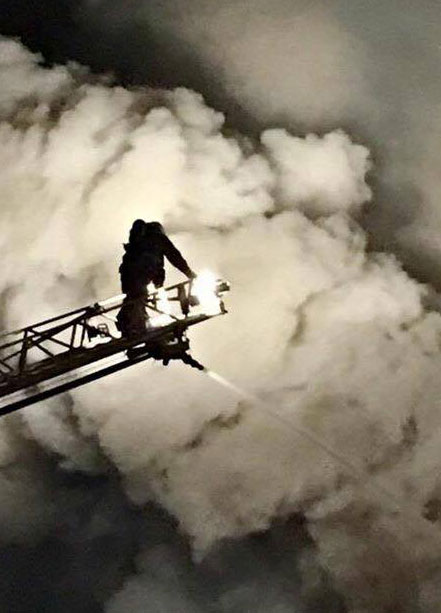 The fire was reported about 5:30 am. with heavy flames through the roof when firefighters arrived. Initial reports indicated the fire may have originated in the garage of the home.
The fire was reported about 5:30 am. with heavy flames through the roof when firefighters arrived. Initial reports indicated the fire may have originated in the garage of the home.
All four occupants of the home were safely evacuate before the flames spread, causing the roof to collapse.
There were no reports of any injuries.
The cause of the fire is under investigation by the Florida State Fire Marshal’s Office.
Two adults and two teenagers were displaced from the home and are being assisted by the American Red Cross. The State Fire Marshal’s Office is investigating. The Ensley, Cantonment, Brent, Beulah, Ferry Pass, Myrtle Grove and Osceola stations of Escambia Fire Rescue responded.
The fire marked the 11th bulb in the “Keep the Wreath Green” fire safety campaign. Each time firefighters respond to a residential fire with damage, a green light bulb will be replaced with a red one to remind citizens of the dangers posed by fires in residential home.
Photo for NorthEscambia.com, click to enlarge.
Attic Fire Damages Molino Home
December 30, 2016
Fire damaged a large Molino home Thursday night, but firefighters were able save the home from major destruction.
An attic fire was reported at the home on Luth Road off Highway 99 just before 9 p.m. Firefighters reported light smoke showing as they arrived on scene at 5,500 square foot, two-story home. The fire was quickly brought under control with significant damage to the attic
Preliminary reports indicated the fire started from a fireplace chimney. There were no injuries reported.
The Molino, Walnut Hill, Cantonment and McDavid stations of Escambia Fire Rescue and the Atmore Fire Department, including a ladder truck, responded to the blaze.
The home’s occupants were displaced, marking the 10th bulb in the “Keep the Wreath Green” fire safety campaign. Each time firefighters respond to a residential fire with damage, a green light bulb will be replaced with a red one to remind citizens of the dangers posed by fires in residential home.
Photos by Kristi Barbour for NorthEscambia.com, click to enlarge.
GED Offered Next Month At The Molino Community Center
December 30, 2016
GED classes will be offered next month at the Molino Community Center.
 Classes will begin on Monday, January 9 and run each Monday and Thursday evening from 6-8 p.m.
Classes will begin on Monday, January 9 and run each Monday and Thursday evening from 6-8 p.m.
This is an open enrollment program so that students may enroll anytime during the semester.
Contact Patricia Harrison at George Stone, 850-941-6200 ext. 2361, for more information. Visit georgestonecenter.com to register. GED classes are provided through a partnership among West Florida Public Libraries, George Stone Technical Center and the Molino Community Center.
Tips From The IRS On Year-End Gifts To Charity
December 30, 2016
The Internal Revenue Service today reminded individuals and businesses making year-end gifts to charity that several important tax law provisions have taken effect in recent years. Some of the changes taxpayers should keep in mind include:
Rules for Charitable Contributions of Clothing and Household Items
 Household items include furniture, furnishings, electronics, appliances and linens. Clothing and household items donated to charity generally must be in good used condition or better to be tax-deductible. A clothing or household item for which a taxpayer claims a deduction of over $500 does not have to meet this standard if the taxpayer includes a qualified appraisal of the item with the return.
Household items include furniture, furnishings, electronics, appliances and linens. Clothing and household items donated to charity generally must be in good used condition or better to be tax-deductible. A clothing or household item for which a taxpayer claims a deduction of over $500 does not have to meet this standard if the taxpayer includes a qualified appraisal of the item with the return.
Donors must get a written acknowledgement from the charity for all gifts worth $250 or more. It must include, among other things, a description of the items contributed.
Guidelines for Monetary Donations
A taxpayer must have a bank record or a written statement from the charity in order to deduct any donation of money, regardless of amount. The record must show the name of the charity and the date and amount of the contribution. Bank records include canceled checks, and bank, credit union and credit card statements. Bank or credit union statements should show the name of the charity, the date, and the amount paid. Credit card statements should show the name of the charity, the date, and the transaction posting date.
Donations of money include those made in cash or by check, electronic funds transfer, credit card and payroll deduction. For payroll deductions, the taxpayer should retain a pay stub, a Form W-2 wage statement or other document furnished by the employer showing the total amount withheld for charity, along with the pledge card showing the name of the charity.
These requirements for the deduction of monetary donations do not change the long-standing requirement that a taxpayer obtain an acknowledgment from a charity for each deductible donation (either money or property) of $250 or more. However, one statement containing all of the required information may meet both requirements.
Reminders
The IRS offers the following additional reminders to help taxpayers plan their holiday and year-end gifts to charity:
- Qualified charities. Check that the charity is eligible. Only donations to eligible organizations are tax-deductible. Select Check, a searchable online tool available on IRS.gov, lists most organizations that are eligible to receive deductible contributions. In addition, churches, synagogues, temples, mosques and government agencies are eligible to receive deductible donations. That is true even if they are not listed in the tool’s database.
- Year-end gifts. Contributions are deductible in the year made. Thus, donations charged to a credit card before the end of 2016 count for 2016, even if the credit card bill isn’t paid until 2016. Also, checks count for 2016 as long as they are mailed in 2016.
- Itemize deductions. For individuals, only taxpayers who itemize their deductions on Form 1040 Schedule A can claim deductions for charitable contributions. This deduction is not available to individuals who choose the standard deduction. This includes anyone who files a short form (Form 1040A or 1040EZ). A taxpayer will have a tax savings only if the total itemized deductions (mortgage interest, charitable contributions, state and local taxes, etc.) exceed the standard deduction. Use the 2016 Form 1040 Schedule A to determine whether itemizing is better than claiming the standard deduction.
- Record donations. For all donations of property, including clothing and household items, get from the charity, if possible, a receipt that includes the name of the charity, date of the contribution, and a reasonably-detailed description of the donated property. If a donation is left at a charity’s unattended drop site, keep a written record of the donation that includes this information, as well as the fair market value of the property at the time of the donation and the method used to determine that value. Additional rules apply for a contribution of $250 or more.
- Special Rules. The deduction for a car, boat or airplane donated to charity is usually limited to the gross proceeds from its sale. This rule applies if the claimed value is more than $500. Form 1098-C or a similar statement, must be provided to the donor by the organization and attached to the donor’s tax return.
If the amount of a taxpayer’s deduction for all noncash contributions is over $500, a properly-completed Form 8283 must be submitted with the tax return.
Free Beans And Rice Giveaway Saturday In Cantonment
December 30, 2016
 Saint Monica’s Episcopal Church, will be distributing free rice and dried beans and other non-perishables on New Year’s Eve from 9 until 11 a.m.m at the church located at 699 South Hwy 95-A in Cantonment. Recipients are also invited to enjoy a free sausage biscuit and coffee. For more information, call the church office at (850) 937-0001.
Saint Monica’s Episcopal Church, will be distributing free rice and dried beans and other non-perishables on New Year’s Eve from 9 until 11 a.m.m at the church located at 699 South Hwy 95-A in Cantonment. Recipients are also invited to enjoy a free sausage biscuit and coffee. For more information, call the church office at (850) 937-0001.


